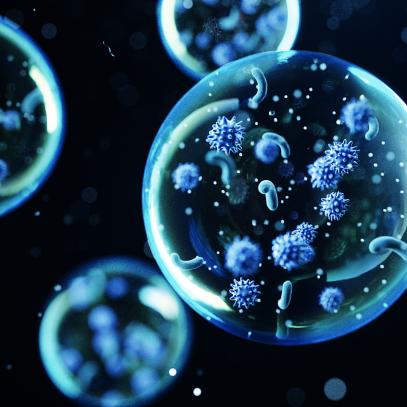Main
Humidification: one of the best things you can do to the air you breathe
Who hasn’t experienced it? It’s cold outside, the heat is running non-stop. You want to feel cozy and snug. But instead, your eyes burn and your skin is dry and itchy. People around you are sick with the flu, coughing is audible in the office and at home. What’s going on? The air is too dry and your body is reacting.

Humidity
Now remember how you feel when walking through a forest or enjoying the breeze at the beach.
What do both have in common?
Healthy, humid air.
It is the key to your health and wellbeing and that's why we all should aim to bring that natural, healty humidity into our indoors.
Humidity management is essential to healthy indoor environments
Knowledge and awareness about relative humidity (RH) by the general public are extremely low. You, too, may realize that you have never stopped to think about the beneficial or disruptive effects of humidity. Though scientific evidence is abundant, relative humidity rarely gets the attention it deserves.
Probably the "invisibility" of humidity to our senses has led to a lack of general understanding about its critical role in maintaining a healthy indoor environment. We can feel temperature - but can’t see, nor immediatley feel indoor humidity.
According to research findings, the ideal relative humidity range for the greatest indoor health safety is 40 to 60%. Unfortunately, most indoor environments hover well below this level during the winter months. It’s hard to remain productive when the climate at the workplace or home causes discomfort and your precious leisure time fails to produce much-needed recuperation.

Recently, the subject has gained added traction. The current pandemic has highlighted once again the relationship between relative humidity and virus transmission. Some seasonal illnesses, though, remain the same. A recent study by UK Chartered Institute for Personnel, published in its 2021 Absence Report, found that even during the pandemic, 88% of companies surveyed reported the common cold and flu remained the most common causes of absence from work.

We know that low humidity is associated with influenza outbreaks in temperate climates. And also that the remedy is so natural and so simple! Researchers have determined that flu-related absenteeism dropped by 66% when children spent their time in properly humidified classrooms.
Yet during winter months we frequently allow indoor relative humidity to drop below the 10-20% mark, which amounts to desert-like conditions – hardly a healthy, productive and comfortable environment.
“I cannot teach anybody anything. I can only make them think.”

Low relative humidity weakens your immune system and helps virus spread
Dry indoor air produces a feeling of overall discomfort and you may notice reduced productivity and fatigue, both the result of insufficient humidity.
Perhaps the least known yet most significant phenomenon is that breathing dry air weakens your immune system’s defense against airborne infection. When indoor relative humidity (RH) drops below 40%, your respiratory immune system’s ability to efficiently capture, remove and fight airborne viruses suffers greatly, rendering you barely a fighting chance against respiratory illnesses like the flu.
In addition, dry air promotes the spread of airborne viruses, allowing them to remain suspended as droplets in the air longer while retaining their degree of infectiousness for longer, thus increasing the likelihood of infection.

Research also tells us that prolonged exposure to dry indoor conditions may also negatively affect the body’s organs, including the brain, kidneys, circulation, skin, eyes and quality of sleep.
“That’s why I recommend humidifiers during the winter, and why I feel the world would be a healthier place if all our public buildings kept their indoor air at 40 to 60% RH.” – Professor Dr Akiko Iwasaki PhD, The Waldemar Von Zedtwitz Professor of immunobiology and professor of molecular, cellular and developmental biology at Yale

The answer: Humidity management
At this point, you are probably asking yourself, what you can do to avoid dry indoor environments. A good place to begin is monitoring the level of humidity in your living spaces using a simple hygrometer. And when it drops below 40%, take corrective measures.
Medical research shows the optimal indoor air parameters for comfort and good health lie in the range of 21–22° C with relative humidity between 40–60%. These levels are vital to producing:
protective indoor environments,
sense of comfort,
better concentration at work and school,
improved sleep,
younger and healthier looking skin,
and many other worthwhile healthy benefits that come with the proper management of relative humidity.
You can humidify during the dry winter months by means of a portable unit for the living room or the bedroom, where you spend most of your time, though such units can be a hassle to clean and fill. (But they are very educational, since you’ll see how enormous is your air’s appetite for water.) For larger spaces, these devices would surely not be enough. There are also permanent integrated humidification solutions that install in ventilation systems where the humidity levels may be consistently precision-controlled to suit your specific health, hygienic and comfort requirements. As this is an automated solution, there’s nothing left for you to do. These diverse solutions are suitable for private homes, schools, offices, medical institutions etc. - basically everywhere where people need to thrive and enjoy a natural protection against airborne infection.
Wholesome indoor environments beget vitality of mind and body.
-
humidity
Has indoor air always been so dry?
How come there's this extreme dryness in new buildings?
-
humidity
Airborne viruses and relative humidity
Humidity fights flu: it significantly reduces the time aerosolized virus droplets float and the virus’ viability. It also minimizes risks to human health by biological contaminants and chemical interactions.
-
humidity
The ideal humidity for sleep
A healthy sleep is vital for body and mind. An optimal relative humidity (RH) of 40 - 60% contributes to an undisturbed, restoring sleep.
-
humidity
How indoor humidity affects our bodies
Dry indoor conditions will decrease our immunity, will negatively affect the body’s organs and the quality of our sleep.



